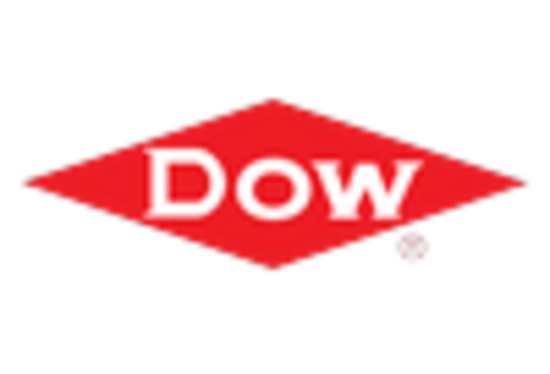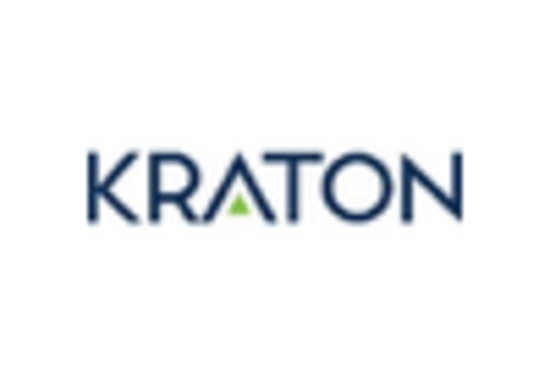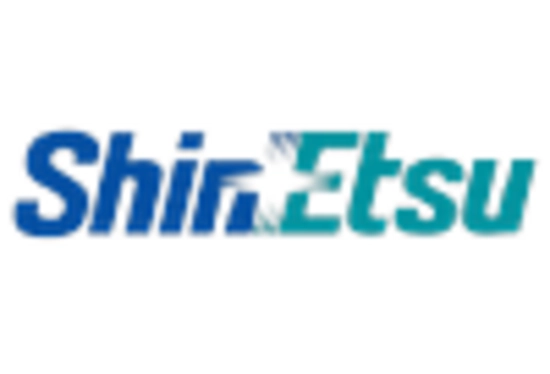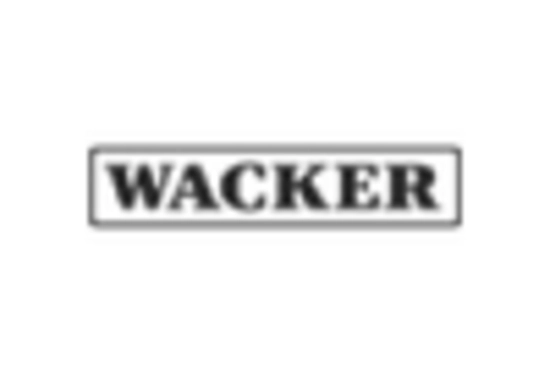Market Share
Introduction: Navigating the Competitive Landscape of Silicone Elastomers
The competitive situation in the silicon rubber market is being reshaped by the rapid development of new technology, by the changing regulatory environment, and by the growing demand for sustainability and performance from consumers. Among the main market players are car manufacturers, chemical companies and new players that use the latest technological developments such as artificial intelligence, automation and IoT to optimize their product offerings and operations. The established companies are investing in green and sustainable solutions to meet the increasingly stringent regulations, while the new entrants are focusing on niche applications and individualization. Strategic trends are increasingly focusing on the localization of production and the optimization of supply chains in the regional markets, especially in Asia-Pacific and North America. The dynamic market situation requires a clear understanding of the technology-driven differentiating factors that will shape market share and competitive advantage in the coming years.
Competitive Positioning
Full-Suite Integrators
These vendors offer comprehensive solutions across the silicone elastomers spectrum, integrating various technologies and services.
| Vendor | Competitive Edge | Solution Focus | Regional Focus |
|---|---|---|---|
| Momentive | Innovative product development | Silicone elastomers and specialty chemicals | Global |
| Wacker Chemie AG | Strong R&D capabilities | Silicone products and solutions | Europe, Asia, Americas |
| DowDuPont | Diverse product portfolio | Silicone elastomers and materials science | Global |
| Shin-Etsu Chemical Co. Ltd. | Leading market position | Silicone materials and compounds | Asia, Americas, Europe |
Specialized Technology Vendors
These vendors focus on niche applications and advanced technologies within the silicone elastomers market.
| Vendor | Competitive Edge | Solution Focus | Regional Focus |
|---|---|---|---|
| KCC CORPORATION | Expertise in specialty silicones | Silicone elastomers for various industries | Asia, Americas |
| China National Bluestar (Group) Co. Ltd. | Strong manufacturing capabilities | Silicone elastomers and related products | Asia, Europe |
| Reiss Manufacturing Inc. | Custom solutions provider | Silicone elastomers for medical applications | North America |
| MESGO S.p.A. | Tailored elastomer solutions | Silicone elastomers for industrial use | Europe, Americas |
Infrastructure & Equipment Providers
These vendors supply essential equipment and infrastructure for the production and processing of silicone elastomers.
| Vendor | Competitive Edge | Solution Focus | Regional Focus |
|---|---|---|---|
| ALLERGAN | Focus on healthcare applications | Silicone elastomers for medical devices | Global |
| Bentec Medical | Specialization in medical technology | Silicone elastomers for healthcare | Global |
| Rogers Corporation | High-performance materials expertise | Silicone elastomers for electronics and automotive | Global |
Emerging Players & Regional Champions
- Silicone Solutions Inc., which specializes in high-performance silicone elastomers for the automotive and aeronautical industries, has recently secured a contract with a major automobile manufacturer to supply custom-made parts made of silicone rubber, and has thereby displaced an established supplier by offering a faster lead time and new formulations.
- Elastomer Innovations, Germany: The company, which has specialised in bio-based silicone elastomers, has recently developed a range of products for the medical sector, offering sustainable alternatives to products from the established suppliers.
- Asiasilicone (China): This company provides cost-effective silicone elastomer for the field of consumer electronics, and has recently signed a contract with a large-scale mobile phone manufacturer to produce silicon parts, and has the advantage of low cost and fast development.
- Silicone Dynamics (India): Provides special silicone elastomers for the construction industry, recently completed a large project for a major road-building project, and complements the leading suppliers by focusing on niche applications and local market needs.
Regional Trends: In 2024, there is a noticeable trend towards the sustainable use of elastomers in the form of a rising number of biodegradable materials, especially in Europe and North America. In Asia-Pacific, the market for the growing number of consumer electronics is driven by cost-effective solutions and new manufacturing methods. The localization of production in response to local demand increases competition among the established companies.
Collaborations & M&A Movements
- Wacker Chemie AG and Momentive Performance Materials Inc. entered into a joint venture to develop advanced silicone elastomers for the automotive sector, aiming to enhance their competitive positioning in the growing electric vehicle market.
- Dow Inc. acquired a minority stake in a startup specializing in bio-based silicone elastomers, intending to diversify its product offerings and meet increasing sustainability demands from consumers and regulators.
- Elkem ASA and Shin-Etsu Chemical Co. formed a strategic partnership to co-develop high-performance silicone elastomers for the healthcare industry, enhancing their market share in a sector that is increasingly focused on biocompatibility and safety.
Competitive Summary Table
| Capability | Leading Players | Remarks |
|---|---|---|
| Biometric Self-Boarding | Momentive Performance Materials, Wacker Chemie AG | The company has now incorporated biometric technology into its silicone elastomers to enable enhanced security applications. Wacker Chemie AG has developed elastomers that can be used in biometric sensors, thus demonstrating its commitment to the improvement of the user experience. |
| AI-Powered Ops Mgmt | Dow Silicones, Shin-Etsu Chemical | Dow Silicones utilizes AI to optimize production processes of silicone elastomers, improving efficiency and reducing waste. Shin-Etsu has implemented AI-driven analytics for better supply chain management, enhancing operational capabilities. |
| Border Control | Elkem ASA, Kraton Corporation | Elkem ASA has developed a silicon rubber which is used in the most advanced control technology, ensuring both reliability and endurance. The Kraton Corporation focuses on sustainable materials for control applications that meet the demands of the authorities. |
| Sustainability | Momentive Performance Materials, Wacker Chemie AG | Momentive is leading in sustainable silicone elastomers with bio-based options, while Wacker Chemie AG emphasizes eco-friendly production processes, both demonstrating a strong commitment to sustainability in their product lines. |
| Passenger Experience | Dow Silicones, Kraton Corporation | Dow Silicones enhances passenger experience through the development of soft-touch silicone elastomers for automotive interiors. Kraton Corporation focuses on high-performance elastomers that improve comfort and safety in passenger applications. |
Conclusion: Navigating the Silicone Elastomers Landscape
The market for elastomers is very much a disputed one, and characterized by a great deal of fragmentation. The market is thus contested by a large number of companies, both old and new, and has to be taken into account in evaluating the overall performance of the industry. There is a tendency for a growth in Asia-Pacific and North America, and the suppliers of elastomers are adjusting their strategies accordingly. The established companies are relying on their established supply chains and their well-known brands, while the new companies are relying on innovation and sustainable development to carve out their own niches. The companies that will be able to compete in the future will be those with a good position in artificial intelligence, automation and flexibility. These are the areas in which the suppliers will have to concentrate in order to be able to take advantage of the opportunities that will arise.








Leave a Comment